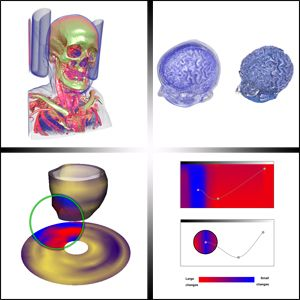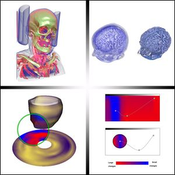Information
- Publication Type: PhD-Thesis
- Workgroup(s)/Project(s):
- Date: October 2011
- Date (Start): October 2008
- Date (End): October 2011
- TU Wien Library:
- 1st Reviewer:
- Vasile Manta
- Eduard Gröller
- 2nd Reviewer:
- Prof. Dr. Florica Moldoveanu
- Prof. Dr. Octavian Pastravanu
- Prof. Dr. Gheorghe Grigoras
- Rigorosum: 17. October 2011
- First Supervisor: Vasile Manta
- Keywords: parameter stability, left ventricle, cardiac parameters, feature enhancement, transfer function, volume rendering, visualization, user interface
Abstract
The extraction and visualization of information from volume data constitute important research avenues in computer graphics and imaging. The rapid development of GPUs with increasing computational power has made it possible to generate intuitive, three-dimensional representations of data sets, which can be tweaked and manipulated interactively.This thesis presents various techniques developed within the field of volume graphics. These have wide applicability in the generation of meaningful images from mainly CT and MRI data sets. The work addresses multiple aspects of volume visualization and rendering, such as the representation, classification and in-depth graphical analysis of the information contained within volume data. Initially, we present generic information on the nature of volume data, the mathematical and physical models behind volume rendering, as well as the rendering algorithms used within our prototyping framework for the rendering of images. Subsequently, we address the problem of volume classification, where we explore the use of various types of transfer functions. These operate on voxel properties such as the gradient, curvature or visibility, allowing for the isolation of increasingly complex and problematic features. We provide alternative, more computationally-efficient ways of approximating some of these properties and show how they can be used for classification purposes. We also provide an effective way of specifying multidimensional transfer functions from 1D components, thus increasing the flexibility and expanding the potential of the classification process.
Another part of the thesis deals with cardiac MRI data. Specifically, we develop a tool for the visual inspection of parameters which influence the status and functionality of the left ventricle. The considered parameters are the thickness and thickening of the myocardial wall, the moment of maximum thickness and the average speed of the wall during a cardiac cycle. Starting from segmentation contours which outline the epicardium and endocardium, we construct surfaces and use these to visualize the distribution of parameter values using color coding. The technique allows for information from multiple slices, over multiple phases and stress levels to be represented on a single 3D geometry, therefore facilitating the analysis of multidimensional data sets comprising a large number of slices. The values of the cardiac parameters are depicted in an intuitive manner, making them easily accessible to both medical staff and patients with no medical training. In the last part of the thesis we develop a method for the analysis of parameters involved in the volume rendering pipeline. The technique involves sampling the parameters across their domains, rendering images for each sample, and computing the differences among these images. The resulting values characterize the behavior and stability of the parameters across their domains. These values are further used to augment various user interfaces, such as sliders or transfer function specification widgets. The newly-modified interfaces use color coding, graphs, arrows and other info-vis techniques to show the potential changes induced by the parameters in images resulting from volume rendering, thus allowing users to make better-informed decisions when adjusting parameter values.
Additional Files and Images
Weblinks
No further information available.BibTeX
@phdthesis{Gavrilescu_2011_VGP,
title = "Visualization and Graphical Processing of Volume Data",
author = "Marius Gavrilescu",
year = "2011",
abstract = "The extraction and visualization of information from volume
data constitute important research avenues in computer
graphics and imaging. The rapid development of GPUs with
increasing computational power has made it possible to
generate intuitive, three-dimensional representations of
data sets, which can be tweaked and manipulated
interactively. This thesis presents various techniques
developed within the field of volume graphics. These have
wide applicability in the generation of meaningful images
from mainly CT and MRI data sets. The work addresses
multiple aspects of volume visualization and rendering, such
as the representation, classification and in-depth graphical
analysis of the information contained within volume data.
Initially, we present generic information on the nature of
volume data, the mathematical and physical models behind
volume rendering, as well as the rendering algorithms used
within our prototyping framework for the rendering of
images. Subsequently, we address the problem of volume
classification, where we explore the use of various types of
transfer functions. These operate on voxel properties such
as the gradient, curvature or visibility, allowing for the
isolation of increasingly complex and problematic features.
We provide alternative, more computationally-efficient ways
of approximating some of these properties and show how they
can be used for classification purposes. We also provide an
effective way of specifying multidimensional transfer
functions from 1D components, thus increasing the
flexibility and expanding the potential of the
classification process. Another part of the thesis deals
with cardiac MRI data. Specifically, we develop a tool for
the visual inspection of parameters which influence the
status and functionality of the left ventricle. The
considered parameters are the thickness and thickening of
the myocardial wall, the moment of maximum thickness and the
average speed of the wall during a cardiac cycle. Starting
from segmentation contours which outline the epicardium and
endocardium, we construct surfaces and use these to
visualize the distribution of parameter values using color
coding. The technique allows for information from multiple
slices, over multiple phases and stress levels to be
represented on a single 3D geometry, therefore facilitating
the analysis of multidimensional data sets comprising a
large number of slices. The values of the cardiac parameters
are depicted in an intuitive manner, making them easily
accessible to both medical staff and patients with no
medical training. In the last part of the thesis we develop
a method for the analysis of parameters involved in the
volume rendering pipeline. The technique involves sampling
the parameters across their domains, rendering images for
each sample, and computing the differences among these
images. The resulting values characterize the behavior and
stability of the parameters across their domains. These
values are further used to augment various user interfaces,
such as sliders or transfer function specification widgets.
The newly-modified interfaces use color coding, graphs,
arrows and other info-vis techniques to show the potential
changes induced by the parameters in images resulting from
volume rendering, thus allowing users to make
better-informed decisions when adjusting parameter values.
",
month = oct,
address = "Favoritenstrasse 9-11/E193-02, A-1040 Vienna, Austria",
school = "Institute of Computer Graphics and Algorithms, Vienna
University of Technology ",
keywords = "parameter stability, left ventricle, cardiac parameters,
feature enhancement, transfer function, volume rendering,
visualization, user interface",
URL = "https://www.cg.tuwien.ac.at/research/publications/2011/Gavrilescu_2011_VGP/",
}

 Thesis
Thesis

